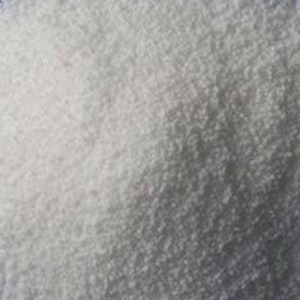
DEFINITION
Saccharin Sodium contains NLT 99.0% and NMT 101.0% of saccharin sodium (C7H4NNaO3S), calculated on the anhydrous basis.
IDENTIFICATION
A. Infrared Absorption.
B. Procedure:
Sample solution: 100 mg/mL
Potassium pyroantimonate solution: Dissolve 2 g of potassium pyroantimonate in 95 mL of hot water. Cool quickly and add 50 mL of a potassium hydroxide solution (50 mg/mL) and 1 mL of sodium hydroxide solution (8.5 in 100). Allow to stand for 24 h, filter, and dilute with water to 150 mL.
Analysis: To 10 mL of the Sample solution add 2 mL of 15% potassium carbonate, and heat to boiling. No precipitate is formed. Add 4 mL of Potassium pyroantimonate solution, and heat to boiling. Allow to cool in ice water and, if necessary, rub the inside of the test tube with a glass rod.
Acceptance criteria: A dense precipitate is formed.
C. Sodium salts impart an intense yellow color to a nonluminous flame.
ASSAY
Procedure:
Sample solution: Dissolve 150 mg of Saccharin Sodium in 50 mL of glacial acetic acid. [Note: Slight heating may be needed to dissolve the sample.]
Analysis: Titrate the Sample solution with 0.1 N perchloric acid, determining the endpoint potentiometrically. Perform a blank determination and make any necessary correction. Each mL of 0.1 N perchloric acid is equivalent to 20.52 mg of saccharin sodium (C7H4NNaO3S).
Acceptance criteria: 99.0%–101.0% on the anhydrous basis
Soluble Saccharin
Ph Eur
C7H4NNaO3Sii205.2ii128-44-9
Action and use: Sweetening agent.
DEFINITION
2-Sodio-1,2-benzisothiazol-3(2H)-one 1,1-dioxide.
Content: 99.0 per cent to 101.0 per cent (anhydrous substance). It may contain a variable quantity of water.
CHARACTERS
Appearance: White or almost white, crystalline powder or colourless crystals, efflorescent in dry air.
Solubility: Freely soluble in water, sparingly soluble in ethanol (96 per cent).
IDENTIFICATION
First identificationiB, E.
Second identificationiA, C, D, E.
A. Melting point: 226C to 230C.
To 5 ml of solution S (see Tests) add 3 ml of dilute hydrochloric acid. A white precipitate is formed. Filter and wash with water. Dry the precipitate at 100-105 °C.
B. Infrared absorption spectrophotometry.
C. Mix about 10 mg with about 10 mg of resorcinol, add 0.25 ml of sulphuric acid and carefully heat the mixture over a naked flame until a dark green colour is produced. Allow to cool, add 10 ml of water and dilute sodium hydroxide solution until an alkaline reaction is produced. An intense green fluorescence develops.
D. To 0.2 g add 1.5 ml of dilute sodium hydroxide solution, evaporate to dryness and heat the residue carefully until it melts, avoiding carbonisation. Allow to cool, dissolve the mass in about 5 ml of water, add dilute hydrochloric acid until a weak acid reaction is produced and filter, if necessary. To the filtrate add 0.2 ml of ferric chloride solution. A violet colour develops.
E. Solution S gives reaction (a) of sodium.
TESTS
Solution S: Dissolve 5.0 g in carbon dioxide-free water and dilute to 50.0 ml with the same solvent.
Appearance of solution: The solution is clear and colourless.
Dissolve 5.0 g in 25 ml of carbon dioxide-free water.
Acidity or alkalinity: To 10 ml of solution S add about 0.05 ml of a 10 g/l solution of PhPh in ethanol (96 per cent). The solution is not pink. Add 0.1 ml of sodium hydroxide 0.1 M. The solution becomes pink.
o- and p-Toluenesulphonamide: Gas chromatography to pass the test.
Readily carbonisable substances: Dissolve 0.20 g in 5 ml of sulphuric acid and keep at 48-50C for 10 min. When viewed against a white background, the solution is not more intensely coloured than a solution prepared by mixing 0.1 ml of red primary solution, 0.1 ml of blue primary solution and 0.4 ml of yellow primary solution with 4.4 ml of water.
Heavy metals: Maximum 20 ppm.
Water: Maximum 15.0 per cent, determined on 0.200 g.
ASSAY
Dissolve 0.150 g in 50 ml of anhydrous acetic acid, with slight heating if necessary. Titrate with 0.1 M perchloric acid, determining the end-point potentiometrically. Carry out a blank titration. 1 ml of 0.1 M perchloric acid is equivalent to 20.52 mg of C7H4NNaO3S.
1,2-Benzisothiazole-3(2H)-one 1,1-Dioxide Sodium Salt;
Sodium o-Benzosulfimide; Soluble Saccharin
C7H4NNaO3S·2H2O --- Formula wt 241.19
INS: 954 CAS: [128-44-9]
DESCRIPTION
Sodium Saccharin occurs as white crystals or as a white, crystalline powder. In powdered form, it effloresces to the extent that it usually contains only about one-third the amount of water indicated in its molecular formula. One gram is soluble in 1.5 mL of water and in about 50 mL of alcohol.
Function: Nonnutritive sweetener.